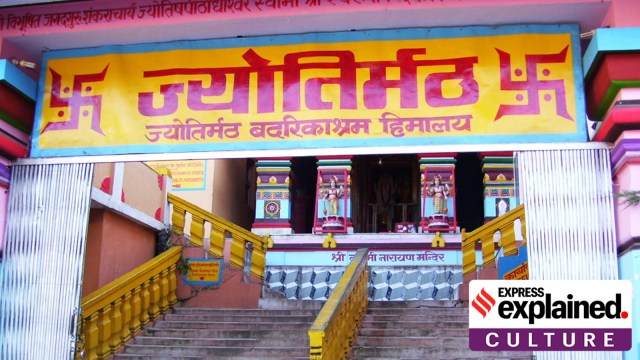Explained: Cultural significance of Uttarakhand’s Joshimath and Kosiyakutoli, now to be renamed
Joshimath and Kosiyakutoli have sites of religious and cultural importance. Here is a brief history of their recent names and why the renaming matters.
 Jyotirmath (also known as Jyotir Peeth) is one of the four cardinal mathas (monasteries) that 8th-century philosopher Adi Shankaracharya is believed to have established across India. (Via Wikimedia Commons)
Jyotirmath (also known as Jyotir Peeth) is one of the four cardinal mathas (monasteries) that 8th-century philosopher Adi Shankaracharya is believed to have established across India. (Via Wikimedia Commons)The Centre approved the Uttarakhand government’s proposal for renaming the Joshimath tehsil in Chamoli district to Jyotirmath, and the Kosiyakutoli tehsil in Nainital district to Pargana Shri Kainchi Dham tehsil on Wednesday (June 12). The move will likely enhance the religious and cultural significance of these areas, in a state that is already a major destination for religious tourism.
The Union Ministry of Science and Technology has also given a No Objection Certificate. It is required as the Survey of India, the body responsible for preparing maps in India, comes under the central ministry.
Joshimath made news last year after massive cracks developed in many of the town’s roads and hundreds of buildings due to land subsidence. On the other hand, the Kosiyakutoli tehsil is well-known for Neem Karoli Baba’s Kainchi Dham Ashram.
The story of Adi Shankaracharya and Jyotirmath
Jyotirmath (also known as Jyotir Peeth) is one of the four cardinal mathas (monasteries) that 8th-century philosopher Adi Shankaracharya is believed to have established across India to promote the Advaita Vedanta philosophy. The Jyotirmath was established for the preservation and dissemination of spiritual knowledge and practices.
It is believed that when Adi Shankaracharya or Adiguru came here, he performed penance under a tree known as the Amar Kalpavriksha. The name “Jyotirmath” comes from the divine light of knowledge he is said to have attained, with ‘jyoti’ meaning divine light.
From Jyotirmath to Joshimath
Jyotirmath was the hill town’s ancient name. Over time, the local population began referring to the area as “Joshimath”. This change was likely gradual and organic, influenced by regional languages, local dialects and the ease of pronunciation. The transition reflects a linguistic and cultural evolution rather than a specific historical event.
The name came into use sometime before the advent of British colonial rule. As a result, this name was registered in the government records. Later, when the tehsil and block were formed, they were also named Joshimath. While “Jyotirmath” was used in a more formal or religious context, “Joshimath” became the more commonly used name.
In recent years, some residents have demanded a change in the name to honour the town’s historical and religious importance. Chief Minister Pushkar Singh Dhami announced the change during a programme organised in Chamoli last year.
The official recognition may further cement the town’s status as a spiritual centre, attracting more pilgrims and thereby boosting local tourism and economic development. However, unchecked tourism and development works have also been cited as causes of environmental concern, particularly due to the region’s ecological sensitivity.
Where “Kosiyakutoli” comes from
While Joshimath represents a subtle change from an older name, the case of Kosiyakutoli is about changing a lesser-known name that lacks wider recognition. Renaming it to Pargana Shri Kainchi Dham aligns its identity with Neem Karoli Baba’s Kainchi Dham Ashram, which is a major site here that attracts devotees from across the world.
In the name “Kosiyakutoli”, “Kosi” refers to the river of the same name which flows through the Nainital district and is important for the Kumaon region of Uttarakhand. Along with adding to the scenic beauty, it matters to the local ecology and economy.
The term “kutoli” is derived from the local language, referring to a village or settlement. In the Kumaoni language, naming a place after a prominent geographical feature like a river is common practice and the names often have meanings connected to the landscape, local history, or cultural attributes.
The link to Neem Karoli Baba
Kosiyakutoli came to be known for its association with Neem Karoli Baba and the Kainchi Dham Ashram he founded in 1962. Also known as Neeb Karori Baba, he was a renowned spiritual guru with followers in India and abroad. Although he passed away in 1973, he is revered to date for his teachings on bhakti yoga and devotion to God.
 Kainchi Dham near Nainital. (Via Wikimedia Commons)
Kainchi Dham near Nainital. (Via Wikimedia Commons)
Among his Western disciples were well-known figures, including Apple co-founder Steve Jobs, former Harvard University professor Ram Dass (earlier named Richard Alpert) and kirtan singer Krishna Das, who helped spread his teachings globally.
Numerous anecdotes and stories of Neem Karoli Baba performing “miracles”, where he is supposed to have materialised objects and healed the sick, contributed to the legend around him. Thousands of devotees flock to the Kainchi Dham Ashram every year, especially on June 15 — the anniversary of the Ashram’s founding.
With the renaming, the site may gain further prominence among tourists. As with other renamed places, there would likely be a gradual phasing out of the old names, alterations in the local identity and diminishing of the historical and cultural narratives associated with the previous names.




- 01
- 02
- 03
- 04
- 05


































